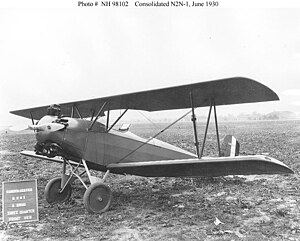Fleet 10
| Model 1 | |
|---|---|
 |
|
| U.S. Navy N2Y-1 with "looped" left mainwheel radius rod | |
| Role | Recreational and training aircraft |
| Manufacturer | Consolidated, Fleet |
| Designer | Reuben Fleet |
| First flight | 9 November 1928 |
The Fleet Model 1 (originally the Consolidated Model 14 Husky Junior) and its derivatives were a family of two-seat trainer and sports biplanes produced in the United States and Canada in the 1920s and 1930s. They all shared the same basic design and varied mainly in their powerplants.
The Fleet Model 1 and its derivatives were all orthodox biplanes with staggered, single-bay wings of equal span and fixed tailskid undercarriage. Accommodation was provided for two in tandem, originally sharing a single open cockpit, but in most examples in separate open cockpits. The fuselage was made of welded steel tube with triangular-layout Warren truss construction pattern side structures typical of the time, and the wings had a wooden spar with duralumin ribs, the entire aircraft being fabric-covered. Despite a superficial resemblance to Consolidated's highly successful Trusty and Husky designs (hence the "Husky Junior" nickname), the Model 14 was an all-new design.
Originally created as a means for Consolidated to enter the civil market, the company abandoned this ambition shortly before the completion of the first prototype. The manufacturing rights were purchased by designer and Consolidated company president Reuben Fleet to put into production under his new enterprise, Fleet Aircraft. It was an immediate success, and in the first year of production alone, over 300 machines were sold. Consolidated quickly responded by buying Fleet Aircraft and retaining it as a subsidiary while opening a second production line at Fort Erie, Ontario, Canada. The Canadian manufacturing was a great success, with some 600 examples built for the Royal Canadian Air Force as the Fleet Fawn (Model 7) and Fleet Finch (Model 16).
A small number of U.S.-built machines were purchased by the U.S. military, including a batch evaluated by the United States Army Air Corps as the PT-16 but not bought in quantity. One initial prototype aircraft and six subsequent specialised production N2Y trainers were purchased by the United States Navy. These N2Y-1 aircraft were equipped with hooks to catch the trapeze on two U.S. Navy airships, the USS Akron and the USS Macon. The N2Y-1 parasite aircraft were used to train pilots that would subsequently fly the longer distance single-seat F9C Sparrowhawks reconnaissance aircraft. The two-seater N2Y-1 also acted as service aircraft, flying passengers to the inroute airships.
...
Wikipedia
